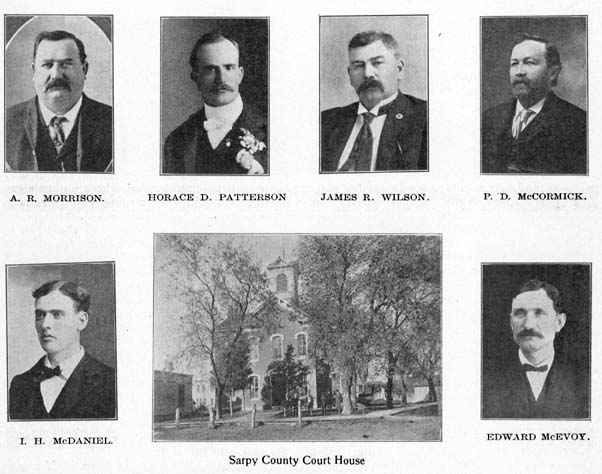1868, in Douglas County, Nebraska. His parents
were of Irish birth and came to Nebraska from Illinois in
1854. Mr. McEvoy was married to Susan Sprague of
Papillion, June 27, 1904. He is a Democrat in politics
and is serving his third term as Sheriff of Sarpy County.
P. D. McCORMICK
was born in Perry County, Ohio, December 22, 1847. His
parents came from Ireland in 1841 and settled in Ohio.
Mr. McCormick came to Nebraska in 1880. He is affiliated
with the Democratic party and was County Treasurer two
terms and is now serving his first term as Clerk of Sarpy
County.
I. H. McDANIEL
was born in Montgomery County, Virginia, August 11, 1872,
and the next year came to Nebraska. He has attended the
Western Normal of Shenandoah, Iowa, and is a graduate of
the Fremont Normal College of Fremont, Nebraska. In 1899
he was married to Gertrude Barber. Mr. McDaniel was
Deputy County Clerk for three and a half years. The
office of Clerk of the District Court was just recently
instituted in Sarpy County and he is the first man to
hold the office.
A. R. MORRISON
was born in Sarpy County, Nebraska, February 10, 1865.
His parents came from Ireland and settled in Sarpy County
in 164. He is a Republican and is serving his first term
as County Treasurer of Sarpy County. He was married to
Miss Bridget Gillespie, March 2, 1892, and they have two
children.
HORACE D.
PATTERSON was born in Rock Bluffs, Cass County,
Nebraska, September 13, 1872. He has lived nearly all his
life in Sarpy County, attended the Papillion high school
and the Fremont Normal and is a surveyor and civil
engineer by profession. He is a member of the Democratic
party and in 1894 and 1895 was Surveyor of Sarpy County,
which office he now holds. For three years he was Deputy
County Surveyor of Butler County and two years in Dodge
County. In 1901 he was married to Miss Tillie Olson of
South Dakota.
SAUNDERS COUNTY.
Saunders County
is named for the last Territorial Governor, Hon. Alvin
Saunders. It is situated in the Platte Valley, and is the
best water county in the state. In addition to the
numerous creeks, there are hundreds of springs. This is
counted one of the six best agricultural counties in the
state, and is one of the three first counties in the
production of broom corn. The soil is a loose, dark brown
and 92 per cent is productive. The farmers are engaged in
the raising of small grain, corn, tame grasses and
vegetables, together with stock raising and dairying. The
four flour and grist mills and the one brick-yard furnish
employment to a great many people. A considerable acreage
is devoted to sugar beets, while corn is the largest
export. Within the last few years, land has doubled in
value. There are a great many timber and fruit trees. The
history of the county begins with the history of Ashland,
because the old Government trail passed through this
town. In 1857 Mr. Reubin Warbritton took up the first
claim in Saunders. He was followed immediately by Joseph
Stambaugh and Mr. John Aughe. The Pawnees gave the early
settlers considerable trouble with petty thefts.
Immigration was so rapid that between the years of 1868
and 1870 the population grew from 400 to 4,594. In 1871
immigration was discontinued because one-half of the land
was in the possession of two rival railroad companies,
and was therefore not offered for sale. In 1872 there
were 2,068 school children and 28 school buildings, now
there are 8,165 school children and 118 school buildings.
The county was organized in 1867 and its present
population is 22,085. The county seat, Wahoo, has 2,100
inhabitants.
CHARLES H. SLAMA
was born in Bohemia, October 16, 1870. He removed to
Wisconsin with his parents in 1876, graduated from the
Law Department of the University of Wisconsin in 1894 and
in 1899 he moved to Colorado and later in the same year
settled in Wahoo. He has been County Judge since
1901.
JOHN H. CRAWFORD
was born at Batavia, Michigan, in November, 1872.
When six months of age his parents removed to Central
City, Nebraska, and in 1880 settled in Wahoo. He
graduated from the Wahoo high school and became a
salesman. He is a member of the
|




